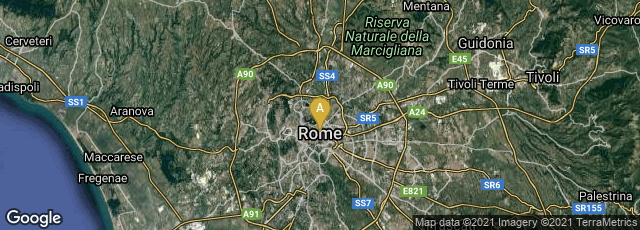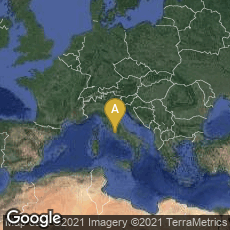

The miniature in the lower left of this leaf from a codex depicts Gregory of Tours and King Chilperic I. BnF Gallica provides the following data regarding this manuscript: Title : Grandes Chroniques de France. Author : Maître du couronnement de Charles VI. Enlumineur. Author : Maître du Livre du sacre de Charles V. Enlumineur. Author : Maître de la Bible de Jean de Sy. Enlumineur. Author : Remiet, Pierre (13..-14..). Enlumineur. Publication date : 1375-1380. Contributor : Henri du Trévou. Copiste. Contributor : Raoulet d'Orléans. Copiste. Contributor : Charles V (roi de France ; 1338-1380). Ancien possesseur....
"The Church gradually replaced the Roman state as the source of order and stability in the course of the fifth and sixth centuries. In the act of disseminating Christianity to the heathen the Church disseminated the remains of Roman learning to the barbarian. Gregory of Tours (540-94) emulated Gregory of Rome (540-604), in that each as bishop of his respective city organized the city's affairs, legal and financial. Each came from a family of senatorial rank, living in the twilight of ancient civilization. The importance to textual transmission of the joining of ancient and medieval, the connection of the past with the future, in the seventh century vividly represented in the conversion of England by Gregory I's missionaries and the growth of monastic culture, culminating in the Northumbrian renewal upon which, in turn, the eighth-century Carolingian renascence in Gaul rests in large part. The Church in England both north and south of the Humber was built by ecclesiastics from Italy; moreover, this took place at a time (c. 660-85) when the still-Byzantine portions of central and southern Italy harboured many ecclesiastics who had fled there to escape Muslim advances in the Middle East and North Africa. This explains why it is that Theodore, archbishop of Canterbury (669-690), was a Greek from Tarsus in Asia Minor, and that his companion Hadrian (d. 709), who knew Greek and taught it at Rochester, was originally from North Africa. The books from which Bede (673-735) studied at Monkwearmouth, and those which Boniface (c.675-754) read at Canterbury, were products of the late antique booktrade, some of which had passed via Cassiodorus' Vivarium and the library of the Lateran Palace, to be brought to England by Theodore, Hadrian, Benedict Biscop (c. 628-89) and their followers" (Rouse, "The Transmission of the Texts," Jenkyns (ed) The Legacy of Rome: A New Appraisal [1992] 45-46).